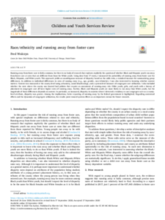Abstract
Running away from foster care is fairly common, but there is no body of research that explores explicitly the question of whether Black and Hispanic youth run away from foster care at rates that are different from those for White youth. Using data from 17 states, I measured the probability of running away from foster care for Black, Hispanic, and White youth. This approach yields an unambiguous measure of disparity based on the odds ratio, a standard measure for summarizing group differences. In addition to individual differences in rates of running away (e.g., age, gender, race/ethnicity), I was also interested in knowing whether context matters. Context was measured at the county-level using urbanicity, social disadvantage, and a system-level measure of congregate care utilization. I also included whether the state where the county was located had policies that require an assessment of running-away risk. Older youth, girls, and youth with a history of placement in congregate care all have higher rates of running away. Further, Black and Hispanic youth are more likely to run away than White youth, but the magnitude of those differences depends on context. In particular, as measured, disparity in counties where I detected a tendency to use congregate care as a county-level attribute, disparity was greater. Among the implications, better reporting of running away by the federal government is highlighted. Regarding contextual effects and the dynamics of congregate utilization, the results point toward system effects as an important avenue for future research

